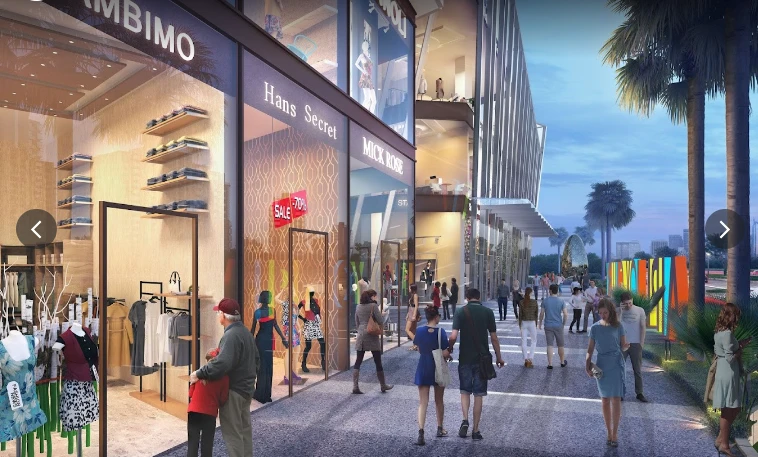Innovative Retail Spaces: Trends Shaping the Future
In the dynamic realm of retail, the landscape is constantly evolving. Retail spaces serve as more than mere points of transaction; they have become experiential hubs where design and innovation intersect to create memorable encounters for consumers. As we look towards the future, the trajectory of retail design is marked by a fusion of creativity, technology, and functionality. In this exploration, we delve into the emerging design trends that are reshaping the concept of retail spaces, paving the way for a transformative experience.
Advance India Projects Limited (AIPL Joy Gallery) is seen as an example of innovation in retail space design. Its unique architectural style and dynamic facade position it as a noteworthy option in the competitive landscape of mixed-use developments. Nestled in the bustling Sector 66 of Gurugram, AIPL Joy Gallery stands as a testament to the evolving nature of retail spaces. AIPL Joy Gallery, as a flagship mixed-use development, offers a comprehensive blend of retail, workspaces, dining, and entertainment options under one roof.
Table of Contents
1. The Future of Workplace Design
2. The Impact of Artificial Intelligence
3. Conclusion
4. Disclaimer
Trends Shaping the Future
Rethinking Layouts: Flexibility and Adaptability
The traditional layout of retail spaces is undergoing a paradigm shift. The era of fixed floor layouts are gone now. Retailers are embracing flexible and adaptable layouts that can evolve with changing consumer needs. The emphasis is on creating modular spaces that can easily be reconfigured to accommodate different products, events, and experiences. By embracing fluidity in design, retail spaces can remain relevant and responsive in an ever-changing market landscape.
Seamless Integration of Technology
Technology is revolutionizing the retail experience, and its integration into physical spaces is becoming increasingly seamless. With interactive displays, augmented reality, smart mirrors, and self-checkout systems, technology is enhancing convenience and personalization for shoppers. Retailers are adopting digital solutions to design immersive environments that connect online and offline shopping experiences seamlessly. Through the power of technology, retailers are not only elevating the shopping journey but also fostering stronger connections with their customers.
Embracing Sustainability and Wellness
In an era marked by environmental consciousness and well-being, sustainability and wellness have emerged as integral elements of retail design. Consumers are gravitating towards brands that prioritize eco-friendly practices and promote holistic lifestyles. Retail spaces are embracing sustainable materials, energy-efficient systems, and biophilic design principles to create healthier environments for both shoppers and the planet. By championing sustainability and wellness, retailers can reduce their environmental footprint and also appeal to the values of socially-conscious consumers.
Creating Immersive Brand Experiences
In the era of online shopping dominance, traditional retailers are reshaping their offerings by prioritizing immersive brand encounters. Physical stores are evolving into destination spots that go beyond mere product transactions; they now provide narratives, emotional connections, and communal experiences. Through pop-up displays, live showcases, curated gatherings, and educational workshops, retailers are crafting moments that engage customers on multiple sensory levels and imprint lasting memories. By nurturing these meaningful engagements, retail environments can nurture customer loyalty and advocacy effectively.
Emphasizing Community and Collaboration
Retail spaces are no longer solitary entities but vibrant hubs that foster community and collaboration. Retailers are partnering with local artisans, designers, and creators to curate unique offerings that celebrate the spirit of craftsmanship and authenticity. Pop-up markets, co-working spaces, and collaborative retail concepts are becoming increasingly popular, blurring the boundaries between commerce and culture. By embracing community-driven initiatives, retail spaces can become catalysts for social engagement and cultural exchange.
Conclusion
As we set forth on a journey into the future of retail, the possibilities are boundless. Retail spaces are not merely places of transaction; they are platforms for innovation, creativity, and human connection. By embracing design trends that prioritize flexibility, technology, sustainability, immersion, and community, retail spaces can redefine the shopping experience and shape the future of commerce.
In summary, the future of retail spaces embodies innovation, creativity, and a profound comprehension of consumer behavior. By embracing design trends that emphasize flexibility, technology, sustainability, immersion, and community, retail spaces have the potential to redefine the shopping experience and establish stronger bonds with consumers. As we gaze ahead, let us engage in a journey of exploration and discovery, pioneering the future of retail spaces through innovative design approaches.
Disclaimer
This content is provided for informational purposes only and is not intended as an advertisement, financial advice, or real estate advice. The views expressed herein are the author's own and do not necessarily reflect the views of AIPL. While every effort has been made to ensure the accuracy and completeness of this information, circumstances can change, and the information may become outdated. We recommend consulting with the professional advisor before making any real estate decisions. References to specific properties, investments, or locations are for illustrative purposes only and should not be considered an endorsement or recommendation. AIPL Group and its directors, subsidiaries, officers, employees, agents, affiliates, and partners, are not liable for any consequence of any action taken by the viewer relying on such material/ information on this blogpost.
Talk to Us
If you have leasing inquiries or other question, we'd love to hear from you.


